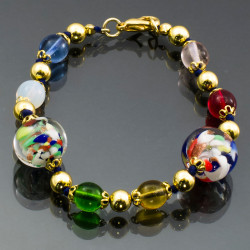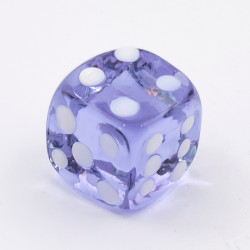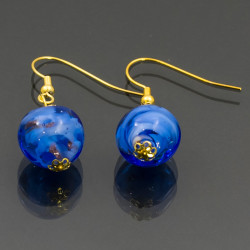
The production of glass artefacts has been, for centuries, an important economic reality for the city of Venice.
The earliest documentation of Murano glass making dates back to 982. Many documents from the end of 1200 confirm the presence of the furnaces along the Rio dei Vetrai in Murano, where, to this day, we find the oldest workshops.
From 1450, thanks to Angelo Barovier, a glass worker from a long standing Murano family, an innovative technique for working glass was introduced, which would be developed over the next two centuries, leading to the creation of glass pieces of amazing and incomparable pureness, such as we know them today.
Murano glass was in its fullest splendour in the 16th century. With the refined techniques and well developed materials in place the glass workers could dedicate themselves to studying and perfecting their form. Blown glass became ever more fine and pure, the moulds and shapes ever more essential and light. The glass began to be bought to adorn the tables of the rich European merchants and noblemen. Such was the value given to these glass objects during this period that an out and out industrial espionage began to develop between the different forges as the craftsmen tried to steal each other’s technologies and produce the most sought after items and not get left behind. The Venetian Republic, in recognition of the their value to the economy, established a reward system for master glass workers who made technological innovations that introduced new methods of working with glass, at the same time, legally protecting the secrets of these important artistic innovations, like the “filigrana a retortoli” and the “filigrana a reticello”.
These privileges, however, were only temporary, once the designated time had elapsed the new techniques became public domain, and any glass workshop was allowed to use them. The authorities also tried to stop the emigration of the master glass makers in an attempt to avoid the export of the technologies employed: in 1605 an important document was drawn up, a registry, called “Il Libro D’Oro” (The Golden Book) that contained the names off all those belonging to the “Magnifica Comunita’ Di Murano” (The Magnicicent Murano Community), these people were known as the glass making nobility of the island.
Though the 20th century the Murano masters continued to respect this millenary tradition by embracing new technologies and using their artistic talents to follow the changing stylistic movements of the times, dedicating themselves to the sophisticated workmanship and personal experimental endeavours that make Murano glass unique, prestigious and inimitable.
ALCHEMY OF MURANO GLASS

The protagonists are the artisans of Venice, skilled and sought-after master glass makers, reintroducing the purity of an antique art. Richly adorned mirrors, glasses weighing only a few grams, carafes and vases taken from old paintings, magnificent objects, legendary lamps, made in the styles of all ages and according to the creativity of the glassmaking masters, to satisfy the whims of the rich families and the European courts of the Renaissance, from the Este to the Gonzaga to the Medici themselves!
The secrets of the art could not be revealed, not even on your death-bed, this was the only way the Venetian government could protect its economy, bestowing upon the glass workers a high social status recognised as a tight, almost esoteric, corporation in which only a few families had access to the furnaces, thus maintaining the power by passing the secrets of the trade from generation to generation.
The secrets of the art could not be revealed, not even on your death-bed, this was the only way the Venetian government could protect its economy, bestowing upon the glass workers a high social status recognised as a tight, almost esoteric, corporation in which only a few families had access to the furnaces, thus maintaining the power by passing the secrets of the trade from generation to generation. Venice was a major hub for commerce and exchange. Glass, along with the technique for its production, had arrived there from the far-east in the Middle Ages, hence many furnaces sprung up on the main island in which they produced mostly glasses and bottles. Because of the numerous fires that started in the glass furnaces and spread across the town, however, the government soon decided to move these workshops to the adjacent smaller island of Murano where the art was refined and perfected over the years till it reached the Golden Age of the Renaissance.
Venice was a major hub for commerce and exchange. Glass, along with the technique for its production, had arrived there from the far-east in the Middle Ages, hence many furnaces sprung up on the main island in which they produced mostly glasses and bottles. Because of the numerous fires that started in the glass furnaces and spread across the town, however, the government soon decided to move these workshops to the adjacent smaller island of Murano where the art was refined and perfected over the years till it reached the Golden Age of the Renaissance. The delicacy of the glass and the splendour of the creations that emerged from the workshops of Murano transformed the tableware, that was utilised for the banquets of the nobility of the Middle Ages and the Renaissance, into a symbol of wealth.
The delicacy of the glass and the splendour of the creations that emerged from the workshops of Murano transformed the tableware, that was utilised for the banquets of the nobility of the Middle Ages and the Renaissance, into a symbol of wealth. There are many masterpieces that illustrate the grandeur of Venetian art; just to mention a few, there is the chalice dedicated to justice from the end of the 1400s, decorated with enamel in a very ancient Islamic style; or the later “Secchiello” (little pail) in “vetro ghiaccio” obtained through thermal shock caused by the immersion of the piece in cold water during the glass blowing process and finally the cups in white opaque glass that looks like porcelain, decorated with images of mythical creatures drawn from the legends of the time; these effects were made possible through the secret alchemy of the Venetian masters who mixed lead and tin oxides into the liquid glass.
The delicacy of the glass and the splendour of the creations that emerged from the workshops of Murano transformed the tableware, that was utilised for the banquets of the nobility of the Middle Ages and the Renaissance, into a symbol of wealth. There are many masterpieces that illustrate the grandeur of Venetian art; just to mention a few, there is the chalice dedicated to justice from the end of the 1400s, decorated with enamel in a very ancient Islamic style; or the later “Secchiello” (little pail) in “vetro ghiaccio” obtained through thermal shock caused by the immersion of the piece in cold water during the glass blowing process and finally the cups in white opaque glass that looks like porcelain, decorated with images of mythical creatures drawn from the legends of the time; these effects were made possible through the secret alchemy of the Venetian masters who mixed lead and tin oxides into the liquid glass.
There are many masterpieces that illustrate the grandeur of Venetian art; just to mention a few, there is the chalice dedicated to justice from the end of the 1400s, decorated with enamel in a very ancient Islamic style; or the later “Secchiello” (little pail) in “vetro ghiaccio” obtained through thermal shock caused by the immersion of the piece in cold water during the glass blowing process and finally the cups in white opaque glass that looks like porcelain, decorated with images of mythical creatures drawn from the legends of the time; these effects were made possible through the secret alchemy of the Venetian masters who mixed lead and tin oxides into the liquid glass. Another astonishing piece is the grandiose chandelier in "Rezzonico" style in which flowers and other decorations could be removed and exchanged according to the event taking place in the hall where it was hanging.
TRADITIONAL METHOD

In the traditional method, the silica sand, which is a particular kind of sand that is melted down at high temperatures to make glass, will have soda added to it in order to facilitate fusion at lower temperatures. Potash, an alternative to soda, typically used in glass produced in Nordic countries, generates a very brilliant glass suitable for cutting and engraving (such as English lead crystal) but not suitable for the, typically Venetian, complex hot working.
The combining of the raw materials takes place the end of the working day and the preparation of the mixture takes all night: the bleaches, colours, stabilizers (like calcium carbonate) and, if need be, opacifiers are added to the two main raw materials. The reverberatory furnace melts down the mixture at approximately 1400 degrees Celsius and in the morning the glass workers will find the molten glass ready for modelling. The molten glass will remain malleable till it reaches 500 degrees Celsius.
The workforce is made up of the so called “piazza” that includes “garzoni” and “serventi” who are coordinated by the master. Once the piece is cold, experts can then be assigned with the job of polishing or other finishing touches, as required. Any decorative glass cutting will be done in a separate laboratory by highly skilled decorators. If the decoration involves enamel the object will be sent to a specialised workshop where it will be painted and fired a second time to set the enamel.
BLOWN GLASS
The ancient invention of blowing glass can be dated as far back as the 1st century BC on the eastern coast of the Mediterranean and remains the most important event it the history of glass. Particularly in Venice, glass blowing was the most privileged technique for the most sought-after and refined glass objects. The Murano masters developed an extraordinary talent for hot working coming up with new techniques like, as mentioned before, the “filigrana” which originated in the 16th century and can be in the “retortoli” or the “reticello” style. These techniques create the effect of a delicate lace structure within the thickness of the glass.
TORCH WORK
This is done by heating a coloured glass rod with a torch. It allows the artist to create any shape desired.
SCULPTURE
This technique is relatively new, only coming to light in the 1930ies. The late development of this technique is due to the due to the technical difficulty associated with working with large masses of incandescent glass. Glass sculpture is an important part of Murano glass production and the Murano glass sculptors are some of the best in the business.
ENAMEL GLASS PAINTING
This art is of Islamic and Byzantine origin and was adopted by the Murano artists in the 13th century. It involves painting the glass with colours made of the same materials as the glass and then firing the object again to melt it on.
GLASS CUTTING
This is usually applied to clear or very lightly coloured glass either with the use of a rotating metal blade or by engraving with a small diamond point.
Murrina
Murrina, a very ancient technique which pre-dates glass blowing, was revived in the 19th century after nearly two thousand years of disuse. It is achieved by melting together small squares of monochrome glass or coloured glass rods to create a very colourful glass structure.

Crystal Tableware
Since the Middle-Ages crystal tableware has been a typical product of the Murano glass workshops. These days the best known designers join forces with these workshops to create the most contemporary designs.
Lamps
The “cesendello” was the most refined lighting system found in houses and churches from the Middle-Ages until the beginning of the 1700s: it was in the shape of an elongated, often roughly conical receptacle, usually designed to be suspended; it was filled with water covered by a layer of oil, in which lay a wick for lighting. Another important product in this field coming out of Murano is the “ciocca”. Introduced in the 18th century, the “ciocca” was a chandelier with many candle-holding arms which also had many decorative items in blown and cut glass attached such as coloured flowers. To this day the “ciocca” is one the symbols of Murano glass.
Glass Beads
The “conterie” are the most simple glass beads, they are rounded or faceted, obtained by softening a long perforated rod and cutting it into sections. The complicated designs, instead, are made by softening a rod of glass and wrapping in around a metal wire to obtain the perforation; the shaping is done using a torch and subsequently the bead will be decorated with coloured glass.
Murano Glass Necklaces
Glass bead necklaces are definitely an irreplaceable element of the feminine attire. Our necklaces are born from the tradition of the Venetian glass bead; they come in all shapes and sizes and suitable for all occasions, sometimes inspired by history and at other times more innovative in style. For example our designs that combine glass beads and gold, for special occasions; glass necklaces that play on the contrast between black and white; traditional mosaic glass necklaces; or finally the more modern items with elements completely extraneous to Murano glass, for the more discerning customers. One can find something to suit any event.
Murrina Pendants
It has only been possible to start a production of Murrina pendants capable of becoming, in a very few years, classic accessories, thanks the simple but ingenious invention of Ercole Moretti.
The invention consists of a small copper plate in the shape of a tear, heart, cross, or simply a circle, inside of which one places tiny rods of many colours, tightly packed together. The plate is then placed in a small oven where the piece is fired, resulting in the rods fusing together forming a colourful compact disc. The objects obtained in this way are very regular in shape and size and will be subsequently ground down and polished.
Murrino Glass Bowls And Plates
One of the most suggestive arts of ancient Rome was that of “murrino” glass: capable, expert hands would place countless fragments of different coloured glass together in harmonious combinations and model them, in the heat of an oven, to create bowls or vases. Now, after 200 years, the same technique has reintroduced itself in Murano: the fruit of passionate and prolonged experience, we have selected a vast array of bowls and plates in “murrino” glass in order to bring to your attention, in modern garb, the charm of this antique and delicate craft.
Our Murrino glass plates and bowl collection is divided into two lines, the more traditional, with a round shape and more traditional designs and the more modern, that are square with corresponding motifs.
Mirrors
The tradition has been preserved! Expert mirror artisans apply the most complex decorative techniques to match the quality of the antiques. During the last centuries the sheets of glass produced manually in Murano (achieved by opening up a blown glass cylinder) were then finished in the workshops of the “specchieri” (mirror makers).




